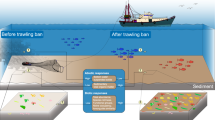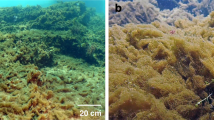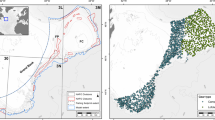Abstract
Sudden beaching of huge seaweed masses smother the coastline and form rotting piles on the shore. The number of reports of these events in previously unaffected areas has increased worldwide in recent years. These 'seaweed tides' can harm tourism-based economies, smother aquaculture operations or disrupt traditional artisanal fisheries. Coastal eutrophication is the obvious, ultimate explanation for the increase in seaweed biomass, but the proximate processes that are responsible for individual beaching events are complex and require dedicated study to develop effective mitigation strategies. Harvesting the macroalgae, a valuable raw material, before they beach could well be developed into an effective solution.
This is a preview of subscription content, access via your institution
Access options
Subscribe to this journal
Receive 51 print issues and online access
$199.00 per year
only $3.90 per issue
Buy this article
- Purchase on Springer Link
- Instant access to full article PDF
Prices may be subject to local taxes which are calculated during checkout

CRISTINA BARROCA; ANSA/JIAN FENG; MAX FRELING; ANDREW HUCKBODY


Similar content being viewed by others
References
Fletcher, R. T. in Marine Benthic Vegetation - Recent Changes and the Effects of Eutrophication (eds Schramm, W. & Nienhuis, P. H.) 7–43 (Springer, 1996).
Valiela, I. et al. Macroalgal blooms in shallow estuaries: controls and ecophysiological and ecosystem consequences. Limnol. Oceanogr. 42, 1105–1118 (1997).
Ye, N. H. et al. 'Green tides' are overwhelming the coastline of our blue planet: taking the world's largest example. Ecol. Res. 26, 477–485 (2011).
Norkko, A. & Bonsdorff, E. Population responses of coastal zoobenthos to stress induced by drifting algal mats. Mar. Ecol. Prog. Ser. 140, 141–151 (1996).
Norkko, A. & Bonsdorff, E. Rapid zoobenthic community responses to accumulations of drifting algae. Mar. Ecol. Prog. Ser. 131, 143–157 (1996).
Arroyo, N. L., Aarnio, K., Mäensivu, M. & Bonsdorff, E. Drifting filamentous algal mats disturb sediment fauna: Impacts on macro–meiofaunal interactions. J. Exp. Mar. Biol. Ecol. 420–421, 77–90 (2012).
Hayden, H. S. et al. Linnaeus was right all along: Ulva and Enteromorpha are not distinct genera. Eur. J. Phycol. 38, 277–294 (2003).
Blomster, J. et al. Novel morphology in Enteromorpha (Ulvophyceae) forming green tides. Am. J. Bot. 89, 1756–1763 (2002).
Laffoley, D. A. et al. The Protection and Management of the Sargasso Sea: The Golden Floating Rainforest of the Atlantic Ocean 1–44 (Washington, 2011).
Lapointe, B. E. A comparison of nutrient-limited productivity in Sargassum natans from neritic vs. oceanic waters of the western North Atlantic Ocean. Limnol. Oceanogr. 40, 625–633 (1995).
Teichberg, M. et al. Eutrophication and macroalgal blooms in temperate and tropical coastal waters: nutrient enrichment experiments with Ulva spp. Glob. Change Biol. 16, 2624–2637 (2010).
van Beusekom, J. E. E. et al. Quality Status Report 2009. Wadden Sea Ecosystem No. 25 (eds Marencic, H. & de Vlas, J.) 1–21 (Common Wadden Sea Secretariat, Trilateral Monitoring and Assessment Group, 2009).
Charlier, R. H., Morand, P. & Finkl, C. W. How Brittany and Florida coasts cope with green tides. Int. J. Environ. Stud. 65, 191–208 (2008).
Saltmarsh, M. A battle between economic mainstays in Brittany. http://www.nytimes.com/2010/08/21/business/energy-environment/21toxic.html?pagewanted=all (New York Times, 2010).
Liu, D. et al. The world's largest macroalgal bloom in the Yellow Sea, China: formation and implications. Estuar. Coast. Shelf Sci. 129, 2–10 (2013).
Sun, S. et al. Emerging challenges: Massive green algae blooms in the Yellow Sea. Nature Preced. http://dx.doi.org/10101/npre.2008.2266.1 (2008).
Keesing, J. K., Liu, D., Fearns, P. & Garcia, R. Inter- and intra-annual patterns of Ulva prolifera green tides in the Yellow Sea during 2007–2009, their origin and relationship to the expansion of coastal seaweed aquaculture in China. Mar. Pollut. Bull. 62, 1169–1182 (2011).
Gao, S. et al. A strategy for the proliferation of Ulva prolifera, main causative species of green tides, with formation of sporangia by fragmentation. PLoS ONE 5, e8571 (2010).
Hu, C. et al. On the recurrent Ulva prolifera blooms in the Yellow Sea and East China Sea. J. Geophys. Res. 115, C05017 (2010).
Liu, F. et al. Understanding the recurrent large-scale green tide in the Yellow Sea: temporal and spatial correlations between multiple geographical, aquacultural and biological factors. Mar. Environ. Res. 83, 38–47 (2013).
Jacobs, A. With surf like turf, huge algae bloom befouls China coast. http://www.nytimes.com/2013/07/06/world/asia/huge-algae-bloom-afflicts-qingdao-china.html (New York Times, 2013).
Yabe, T. et al. Green tide formed by free-floating Ulva spp. at Yatsu tidal flat, Japan. Limnology 10, 239–245 (2009).
Sfriso, A. & Marcomini, A. Decline of Ulva growth in the lagoon of Venice. Bioresour. Technol. 58, 299–307 (1996).
Facca, C., Pellegrino, N., Ceoldo, S., Tibaldo, M. & Sfriso, A. Trophic conditions in the waters of the Venice lagoon (Northern Adriatic Sea, Italy). Open Oceanogr. J. 5, 1–13 (2011).
Geertz-Hansen, O., Sand-Jensen, K., Hansen, D. F. & Christiansen, A. Growth and grazing control of abundance of the marine macroalga, Ulva lactuca L. in a eutrophic Danish estuary. Aquat. Bot. 46, 101–109 (1993).
Kamermans, P. et al. Effect of grazing by isopods and amphipods on growth of Ulva spp. (Chlorophyta). Aquat. Ecol. 36, 425–433 (2002).
Bäck, S., Lehvo, A. & Blomster, J. Mass occurrence of unattached Enteromorpha intestinalis on the Finnish Baltic Sea coast. Ann. Bot. Fenn. 37, 155–161 (2000).
Lin, H. Z. et al. Genetic and marine cyclonic eddy analyses on the largest macroalgal bloom in the world. Environ. Sci. Technol. 45, 5996–6002 (2011).
Zhang, X. W. et al. Somatic cells serve as a potential propagule bank of Enteromorpha prolifera forming a green tide in the Yellow Sea, China. J. Appl. Phycol. 22, 173–180 (2010).
Zhang, J. H. et al. Growth characteristics and reproductive capability of green tide algae in Rudong coast, China. J. Appl. Phycol. 25, 795–803 (2013).
Viscusi, G. Fear of noxious 'green tides' drives tourists from beaches of Brittany http://www.boston.com/news/science/articles/2011/08/14/fear_of_noxious_green_tides_drives_tourists_from_beaches_of_brittany/ (Boston Globe, 2011).
Diaz, M., Darnhofer, I., Darrot, C. & Beuret, J.-E. Green tides in Brittany: What can we learn about niche–regime interactions? Environ. Innov. Soc. Transitions 8, 62–75 (2013).
Samuel, H. French protesters say Brittany will be François Hollande's 'cemetery' http://www.telegraph.co.uk/news/worldnews/francois-hollande/10423888/French-protesters-say-Brittany-will-be-Francois-Hollandes-cemetery.html (The Telegraph, 2013).
Jing, L. Seaweed farming linked to Qingdao's green tide of algae http://www.scmp.com/news/china/article/1284156/cause-qingdaos-green-tide-algae-mystery (South China Morning Post, 2013).
Williams, A. & Feagin, R. Sargassum as a natural solution to enhance dune plant growth. Environ. Manage. 46, 738–747 (2010).
Gower, J. & King, S. Distribution of floating Sargassum in the Gulf of Mexico and the Atlantic Ocean mapped using MERIS. Int. J. Remote Sens. 32, 1917–1929 (2011).
Johnson, D. L. & Richardson, P. L. On the wind-induced sinking of Sargassum. J. Exp. Mar. Biol. Ecol. 28, 255–267 (1977).
Hemphill, A. Change is in the air – seaweed, seaweed everywhere! http://arlohemphill.com/2011/08/26/change-is-in-the-air-seaweed-seaweed-everywhere/. (Arlo Hemphill, 2013).
Gower, J., Young, E. & King, S. Satellite images suggest a new Sargassum source region in 2011. Remote Sens. Lett. 4, 764–773 (2013).
Ackah-Baidoo, A. Fishing in troubled waters: oil production, seaweed and community-level grievances in the Western Region of Ghana. Community Dev. J. 48, 406–420 (2013).
McDiarmid, J. Western Ghana's fisherfolk starve amid algae infestation http://www.ipsnews.net/2012/04/western-ghanarsquos-fisherfolk-starve-amid-algae-infestation/ (IPS, 2011).
Froese, R. & Pauly, D. (eds). FishBase. http://www.fishbase.org (Fishbase, 2013).
Anderson, D. M., Cembella, A. D. & Hallegraeff, G. M. Progress in understanding harmful algal blooms: paradigm shifts and new technologies for research, monitoring, and management. Annu. Rev. Mar. Sci. 4, 143–176 (2012).
GEOHAB. Global Ecology and Oceanography of Harmful Algal Blooms (SCOR and IOC, 2001).
Nelson, T. A., Lee, D. J. & Smith, B. C. Are “green tides” harmful algal blooms? Toxic properties of water-soluble extracts from two bloom-forming macroalgae, Ulva fenestrata and Ulvaria obscura (Ulvophyceae). J. Phycol. 39, 874–879 (2003).
Harder, T., Dobretsov, S. & Qian, P.-Y. Waterborne polar macromolecules act as algal antifoulants in the seaweed Ulva reticulata. Mar. Ecol. Prog. Ser. 274, 133–141 (2004).
Algae Industry Magazine. Olmix opens algae biorefinery in Brittany http://www.algaeindustrymagazine.com/olmix-opens-algae-biorefinery-brittany/ (Algae Industry Magazine, 2013).
South Atlantic Fishery Management Council. Fishery Management Plan For Pelagic Sargassum Habitat Of The South Atlantic Region http://www.gc.noaa.gov/documents/gcil_safmc_fmp.pdf (NOAA, 2002).
Pauly, D., Christensen, V., Dalsgaard, J., Froese, R. & Torres, F. Fishing down marine food webs. Science 279, 860–863 (1998).
Acknowledgements
We thank C. Barroca, A. Huckbody, E. Fuller and M. Freling for sharing their photographs and experience, I. Valiela for comments on an earlier draft and P. Kullberg for updates.
Author information
Authors and Affiliations
Corresponding authors
Ethics declarations
Competing interests
The authors declare no competing financial interests.
Additional information
Reprints and permissions information is available at www.nature.com/reprints.
Rights and permissions
About this article
Cite this article
Smetacek, V., Zingone, A. Green and golden seaweed tides on the rise. Nature 504, 84–88 (2013). https://doi.org/10.1038/nature12860
Received:
Accepted:
Published:
Issue Date:
DOI: https://doi.org/10.1038/nature12860
This article is cited by
-
Genome-wide SNP markers provided insights into the reproductive strategy and genetic diversity of the green tide causative species Ulva prolifera in China
Journal of Oceanology and Limnology (2024)
-
Estimation and verification of green tide biomass based on UAV remote sensing
Journal of Oceanology and Limnology (2024)
-
Temporal Characterization of Sargassum (Sargassaceae, Phaeophyceae) Strandings in a Sandy Beach of Quintana Roo, Mexico: Ecological Implications for Coastal Ecosystems and Management
Thalassas: An International Journal of Marine Sciences (2024)
-
Iron limitation of kelp growth may prevent ocean afforestation
Communications Biology (2023)
-
Nutrient and arsenic biogeochemistry of Sargassum in the western Atlantic
Nature Communications (2023)
Comments
By submitting a comment you agree to abide by our Terms and Community Guidelines. If you find something abusive or that does not comply with our terms or guidelines please flag it as inappropriate.



